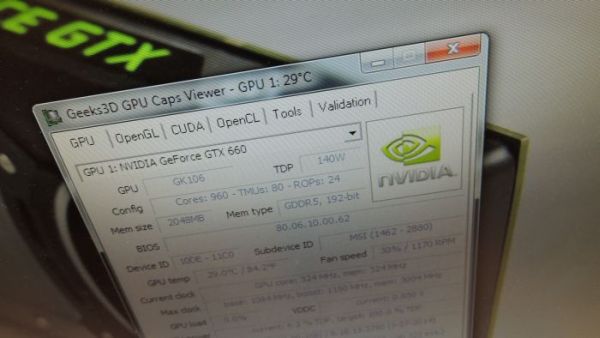

- Gpu caps viewer 1.5.0 drivers#
- Gpu caps viewer 1.5.0 update#
- Gpu caps viewer 1.5.0 driver#
- Gpu caps viewer 1.5.0 software#
- Gpu caps viewer 1.5.0 code#
(Note: I do not recommend you to download any software from the Internet. (gl.glGetString(GL.GL_VENDOR)) Īn easy way to determine more of your OpenGL capabilities can be done with the program GPU Caps Viewer.
Gpu caps viewer 1.5.0 code#
You can determine the version and vendor of you OpenGL in Java with some code like:
Gpu caps viewer 1.5.0 driver#
For instance I found a driver for my stationary PC with a nVidia GeForce 8600 GT on nVidias hompage.
Gpu caps viewer 1.5.0 drivers#
If you have a good graphic card vendor they may very well have drivers for OpenGL to download from their home page. Most Windows system has very old versions of OpenGL installed. You can then copy the code for that class from the Wikipedia site about jogl.Ī note. Create a new class called JOGLTetrahedron. GeeXLab 0.49 Released for Windows and Linux (Updated: v0.49.Now we’ll want to test.QB 0.2.0 Rubik’s Cube Simulator Released for Windows and Linux.files ii eog 43.1-1 amd64 Eye of GNOME graphics viewer program rc ethtool. (Demo) Knob and Toggle Widgets (Dear ImGui) chroot and namespace manipulation ii budgie-extras-common 1.5.0-1 amd64.

D3d12info: GPU info via Direct3D 12 and other sources.glslDebugModule: GLSL debugging assistance module.Jolt Physics: Rigid Body and Collision Detection Library.MX Linux MX-23 released (based on Debian 12).Building a Submersible PC for ULTIMATE cooling.Moore Threads MTT S80 GPU Review - A New Challenger Appears.NVIDIA GeForce driver 537.13 Game Ready / Quadro.Intel Graphics Driver 31.0.101.4669 beta for Arc / Iris GPUs.! updated: ZoomGPU 1.26.0 (GPU monitoring library). ! updated with latest GeeXLab SDK libs (GeeXLab 0.33.0.0). A new mesh shaderĭemo (Vulkan) for NVIDIA Turing GPUs has been added. (demos based on the first Vulkan plugin have been removed). + GeeXLab demos: added new Vulkan demos based on the new Vulkan2 plugin ! GPU panel: Texture and pixel fillrates: boost clock speed is used instead of base clock speed.
Gpu caps viewer 1.5.0 update#
+ GPU panel: added raytracing and tensor cores on NVIDIA Turing+ GPUs. This update of GPU Caps Viewer comes with the support of recent GPUs from NVIDIA, AMD and Intel. ! updated: ZoomGPU 1.26.1 (GPU monitoring library) + GPU panel: added more details about Radeon GPUs (ASIC type, CUs and WGPs). The ASIC family, the number of compute units and the number of RDNA work group processors are displayed in the GPU panel for AMD Radeon GPUs. GPU Caps Viewer 1.45.1 is a maintenance release that comes with the latest AMD AGS 5.4.1.

A demo on mesh shaders (for NVIDIA Turing GPUs only) is included in the new demos. New GeeXLab demos has been added and Vulkan demos are now based on the new Vulkan2 plugin. GPU Caps Viewer has been updated with new demo OpenGL HW geometry instancing - shader model 4.0 required detection of GeForce GTX 280/260 and Radeon HD 4850/4870/4870X2. Still on NVIDIA, the pixel and texture fillrates have been fixed and are now based on the boost clock speed (minor bug, in previous versions, fillrates were based on the base clock). GPU Caps Viewer is a free and highly-featured tool that quickly describes the essential capabilities of your graphics card/GPU including GPU type, amount of VRAM, OpenGL API support. GPU Caps Viewer 1.45.0 now displays the number of raytracing and tensor cores for NVIDIA Turing (and Ampere?) GPUs. VRAM, OpenGL, Vulkan, OpenCL and CUDA API support level. GPU Caps Viewer is a graphics card / GPU information and monitoring utility that quickly describes the essential capabilities of your GPU including GPU type, amount of Forum thread (EN) for feedbacks or bug-reportsĪ new version of GPU Caps Viewer is available. prepare for using accelerated GLX implementations from GPU vendors.Zustzlich knnen diverse OpenGL-Demos abgespielt werden und die Grafikkarte einem Stresstest unterzogen werden. GPU_Caps_Viewer_Setup_v1.45.1.0.exe hash codes: GPU Caps Viewer ist ein Tool fr Windows XP und Vista, mit dem man sich Informationen mit dem Schwerpunkt OpenGL (Open Graphics Library) zu seiner Grafikkarte anzeigen lassen kann.


 0 kommentar(er)
0 kommentar(er)
